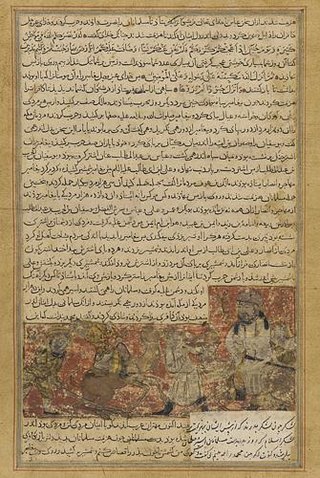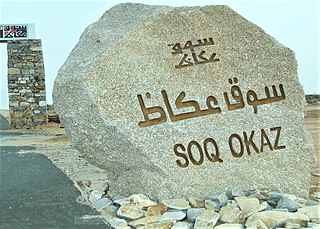
The Quraysh or Qureshi is an Arab tribe that inhabited and used to control Mecca and the Kaaba. Comprising ten main clans, it includes the Hashim clan into which the Islamic prophet Muhammad was born. By 600 CE, the Quraysh had become wealthy merchants, dominating trade between the Indian Ocean, East Africa, and the Mediterranean. They ran caravans to Gaza and Damascus in summer, and Yemen in winter. They also mined and pursued other enterprises on these routes, placing business interests first.

The Banu Thaqif is an Arab tribe which inhabited, and still inhabits, the city of Ta'if and its environs, in modern Saudi Arabia, and played a prominent role in early Islamic history.
Abd Manaf al-Mughirah ibn Qusai was a Qurayshi and great-great-grandfather of the Islamic prophet Muhammad. His father was Quṣai ibn Kilāb.

The Battle of Hunayn was a conflict between the Muslims of the Islamic prophet Muhammad and the tribe of Qays in the aftermath of the conquest of Mecca. The battle took place in 8 AH in the Hunayn valley on the route from Mecca to Taif. The battle ultimately ended in a decisive victory for the Muslims, and it is one of the few battles mentioned by name in the Qur'an, where it appears in Surat at-Tawbah.
ʿAbbād ibn Bishr (c.597–632) was a companion of the Islamic prophet Muhammad. After the Hijrah of Muhammad and his followers from Mecca, 'Abbad and his clansmen were given the name of Ansar for their assistance in giving shelter to the Muslims who came to their town. His Kunya or Teknonymy were Abu al-Rabi'.

Suhayl ibn ʿAmr, also known as Abū Yazīd, was a contemporary of the Islamic prophet Muhammad, and a prominent leader among the Quraysh tribe of Mecca. Clever and articulate, he was known as the Khatib (orator) of his tribe, and his opinion carried great weight among them. He brokered the famous Treaty of al-Hudaybiya with Prophet Muhammad on the side of Quraysh in 628 AD.
There were several Arabian tribes that interacted with Muhammad.
The Ghaṭafān were an Arab tribal confederation originally based northeast of Medina. The main branches of the Ghatafan were the tribes of Banu Abs, Banu Dhubyan and Ashja'. They were one of the Arab tribes that interacted with Muhammad. They are notable for allying themselves with the Quraysh in the Battle of the Trench.
Abu Abd Allah al-Mughira ibn Shu'ba ibn Abi Amir ibn Mas'ud al-Thaqafi ; c. 600–671), was a prominent companion of the Islamic prophet Muhammad and was known as one of the four 'shrewds of the Arabs'. He belonged to the tribe of Thaqif of Ta'if, who were part of the early Islamic elite. He served as governor of Kufa, one of the two principal Arab garrisons and administrative centers of Iraq, under Caliph Umar in 642–645. In his old age, al-Mughira was again made governor of Kufa, serving under the Umayyad caliph Mu'awiya I from 661 until his death in 671. During his second governorship, he ruled with virtual independence from the caliph.
Muhammad led the Conquest of Mecca in Ramadan of the Islamic year 8 AH. The Quraysh in Mecca was Muhammad's final major rival in the Arabian Peninsula, and following the conquest, Muhammad focused his military operations on further expansion of his Islamic realm to the north, with a campaign against the Ghassanids and the Byzantine Empire.

The Ansar or Ansari are the local inhabitants of Medina who took the Islamic prophet Muhammad and his followers into their homes when they fled from Mecca during the hijra. They belonged to the tribes of Banu Khazraj and Banu Aus.
The Otaibah is one of the biggest Arabian tribes originating in the Arabian Peninsula. Their distribution spans throughout Saudi Arabia, especially in Najd and Hejaz. and the Middle East. The Otaibah are descended from the Bedouin. They trace back to the Mudar family and belong to the Qays ʿAylān confederacy through its previous name, Hawazin.
Qays ʿAylān, often referred to simply as Qays were an Arab tribal confederation that branched from the Mudar group. The tribe appears to have functioned as a unit in pre-Islamic Arabia. However, by the early Umayyad Caliphate (661-750), its constituent tribes consolidated into one of the main tribal political factions of the caliphate.

Kinana is an Arab tribe based around Mecca in the Tihama coastal area and the Hejaz mountains. The Quraysh of Mecca, the tribe of the Islamic prophet Muhammad, was an offshoot of the Kinana. A number of modern-day tribes throughout the Arab world trace their lineage to the tribe.
Sakhr ibn Harb ibn Umayya, commonly known by his kunyaAbu Sufyan, was a prominent opponent-turned companion and father-in-law of the Islamic prophet Muhammad. He was the father of the first Umayyad caliph Mu'awiya I and namesake of the Sufyanid line of Umayyad caliphs which ruled from 661 to 684.
The Banu Kilab was an Arab tribe in the western Najd where they controlled the horse-breeding pastures of Dariyya from the mid-6th century until at least the mid-9th century. The tribe was divided into ten branches, the most prominent being the Ja'far, Abu Bakr, Amr, Dibab and Abd Allah. The Ja'far led the Kilab and its parent tribe of Banu Amir, and, at times, the larger Hawazin tribal confederation from the time of the Kilab's entry into the historical record, c. 550, until the advent of Islam, c. 630, except for two occasions when the larger Abu Bakr was at the helm. Under the Ja'far's leadership the Kilab defeated rival tribes and the Lakhmid kings and eventually became guards of the Lakhmid caravans to the annual fair in the Hejaz. The killing of a Ja'far chief as he escorted one such caravan led to the Fijar War between the Hawazin and the Quraysh of Mecca.

Sūq ʿUkāẓ is a historical souk at ʿUkāẓ, between Nakhla and Taif, in Saudi Arabia. It was the largest and best known annual fair in pre-Islamic times. Today it is a popular tourist destination.

The Banu Ghani was an Arab tribe that inhabited the area between Bisha and Diriyah in pre-Islamic Arabia and parts of which migrated to Syria during the Muslim conquest of that region.
Zuhayr ibn Jadhīma ibn Rawāḥa al-ʿAbsī was the chieftain of the Banu Abs who ultimately became the leader of the Ghatafan and Hawazin tribal confederations in pre-Islamic Arabia in the mid-6th century.
The Fijar Wars were a series of battles that took place in the late 6th century mainly between two major tribal confederations of Arabia, the Quraysh and the Hawazin. According to the sources, the fighting took place on eight days over the course of four years.









